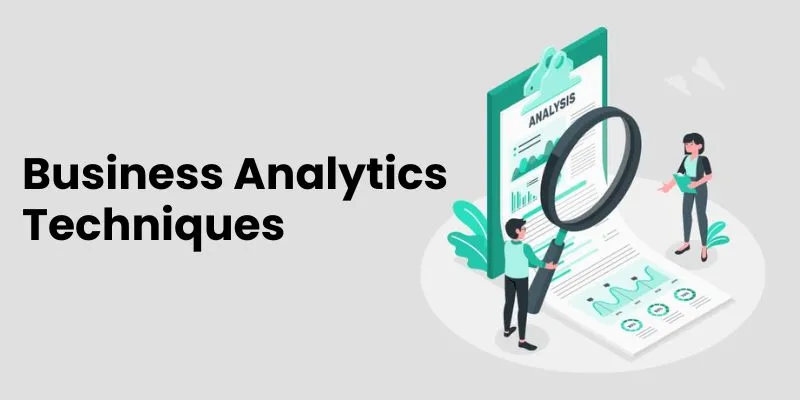What are the Techniques of Business Analytics?
Businesses depend on insights from massive volumes of data in today’s data-driven world to inform strategic decisions, improve operational effectiveness, and gain a competitive edge. Business Analytics is the cornerstone of this process, offering a suite of techniques and tools to extract actionable insights from data. In this blog, we’ll explore the fundamentals of Business Analytics, delve into various analysis techniques and tools, and discuss the different types of Business Analytics that empower organizations to harness the power of data for success.
Business Analytics
Business Analytics encompasses the processes, technologies, and techniques used to analyze data and derive insights that inform decision-making and drive business performance. Data must be gathered, cleaned, transformed, and analyzed in order to find patterns, trends, and linkages that may be utilized to improve workflows, lower risks, and spot business possibilities.
At its core, Business Analytics aims to answer key business questions, solve complex problems, and support evidence-based decision-making across various organizational functions and departments. Whether understanding customer behavior, optimizing supply chain operations, or predicting future trends, Business Analytics provides the Business Analyst tools and techniques to unlock the value hidden within data.
Business Analysis Techniques
Descriptive Analytics
Summarizing historical data to provide insights into past events is the main goal of descriptive analytics. In order to assist stakeholders in understanding trends, patterns, and key performance indicators (KPIs) pertinent to their business objectives, this includes data visualization, dashboards, and reporting methodologies. Descriptive analytics not only provides a brief summary of current affairs, but it also establishes the framework for more challenge analysis techniques.
Diagnostic Analytics
This aims to reveal the root causes of past events or outcomes by examining historical data in greater detail. This involves Business Analytics techniques such as data mining, correlation analysis, and regression analysis, which help identify relationships between variables and understand the factors driving specific outcomes. Diagnostic analytics helps stakeholders gain deeper insights into why certain events occurred, enabling them to make informed decisions about future actions.
Predictive Analytics
This uses statistical modeling & machine learning algorithms to forecast future events/outcomes based on historical data. This covers methods including time series analysis, decision trees, random forests, and neural networks in machine learning, as well as predictive modeling. Predictive analytics enables organizations to anticipate trends, identify potential risks, and make proactive decisions to capitalize on opportunities or mitigate threats.
Prescriptive Analytics
Prescriptive analytics goes beyond predicting future outcomes to recommend actions that will optimize business performance. This is one of the essential Business Analysis techniques. This involves advanced optimization techniques, simulation modeling, and decision support systems that help stakeholders evaluate various scenarios and determine the best course of action. Prescriptive analytics provides actionable insights that guide decision-making and drive continuous improvement within organizations.
Tools of Business Analysis
Data Visualization Tools
These tools such as Tableau, Power BI, and QlikView allow users to create interactive charts, graphs, and dashboards that transform raw data into visual insights. These tools enable stakeholders to explore data visually, identify patterns, and communicate findings effectively to decision-makers.
Statistical Software
Statistical software packages such as R, Python, and SAS provide powerful tools for conducting advanced analysis techniques like regression analysis, clustering & predictive modeling. These tools offer various statistical functions and algorithms that enable users to analyze data and derive actionable insights. This is one of the important Business Analysis tools.
Business Intelligence Platforms
Business intelligence platforms such as SAP BusinessObjects, IBM Cognos, and Oracle BI provide integrated data analysis, reporting, and dashboarding solutions. These platforms provide features like data integration, ad-hoc querying, and multidimensional analysis that support decision-making at all organizational levels.
Types of Business Analytics
Descriptive Analytics
This summarizes historical data to provide insights into past performance and trends. It includes techniques such as data visualization, reporting, and dashboards that help stakeholders understand what has happened in the past and why.
Diagnostic Analytics
This aims to identify the root causes of past events or outcomes by examining historical data in detail. It includes techniques such as correlation analysis, regression analysis, and data mining that help stakeholders understand why certain events occurred and what factors contributed to specific outcomes. This is one of the important types of Business Analysis.
Predictive Analytics
Predictive analytics involves forecasting future events or outcomes based on historical data & statistical modeling techniques. It includes predictive modeling, time series analysis, and machine learning algorithms that help stakeholders anticipate trends, identify risks, and make proactive decisions.
Prescriptive Analytics
Prescriptive analytics goes beyond predicting future outcomes to recommend actions that optimize business performance. It involves advanced optimization techniques, simulation modeling, and decision support systems that help stakeholders evaluate scenarios and determine the best action.
The role of Business Analytics in helping organizations harness the power of data to drive strategic decision-making & achieve business objectives. Whether descriptive analytics to summarize historical data, diagnostic analytics to uncover root causes, predictive analytics to forecast future outcomes, or prescriptive analytics to recommend optimal actions, Business Analytics provides the framework for data-driven decision-making and continuous improvement within organizations. Several MBA Colleges in Chennai provide insights into Business Analytics Techniques. Businesses can gain valuable insights into past performance, understand present trends, and make informed predictions by leveraging a combination of Business Analyst tools and techniques.
Authored by Priya S.,
I aspire to learn more about the new area of technology and business. If you’re eager to find out more about what makes a successful job, connect with me on LinkedIn.

